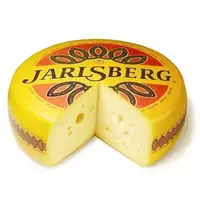Jarlsberg cheese

Such a northern Scandinavian country as Norway is proud of its, albeit not the oldest in Europe, but still a long-standing cheese-making tradition. One of the most famous varieties of Norwegian cheese is Jarlsberg. This semi-solid cheese is made from pasteurized and high-quality cow's milk. Jarlsberg cheese belongs to the so-called rennet varieties, since in the production process the product uses a rennet enzyme, which significantly speeds up the fermentation process of milk.
Thanks to the unique production technology, Jarlsberg cheese stands out for its sweet and pronounced cheese taste, as well as the presence of large cheese eyes or holes. Jarlsberg's cheese body is characterized by a warm creamy color, and in addition, the presence of a yellow wax crust. Jarlsberg cheese is considered a relative of Swiss Emmental cheese.
The history of Norwegian cheese is a vivid confirmation of this. It turns out that in 1830 Swiss cheesemakers arrived in Norway to share their knowledge with European colleagues. It is believed that it was that period of time that marked the beginning of the cheese-making tradition in Norway. The second round of development of the Norwegian cheese industry occurred in the 50s of the last century, when Norwegian master cheesemakers discovered the Jarlsberg cheese to the world.
Moreover, the cheese recipe belongs to the pioneer of cheese making in Norway, Anders Larsen, who at the beginning of the 19th century opened a small production of the product. Although Mr. Larsen's cheese resembled a Swiss product in its appearance, Jarlsberg's taste spoke eloquently about the identity of the Norwegian product. Jarlsberg currently has an important place in the country's national exports.
Cheese is especially popular in the United States, as well as in Europe. Jarlsberg got its original name thanks to the Norwegian city of the same name, on whose cheese factory this variety of semi-hard cheese was first made. It is worth noting that Jarlsberg cheese is served to the table as a self-contained snack or snack.
The cheese is also used to make salads, snacks and puree soups. Jarlsberg is served as a dessert accompanied by fruit and wine. In the process of cheese production, rennet is introduced into cow's milk, which starves the original raw materials. As a result, whey and curd mass are formed, which is salted and then maintained for a period of 1 to 15 months.
Both the young Jarlsberg cheese and the aged noble product are popular. The young cheese has a light, creamy flavour with sweet hues and a light, almost barely noticeable finish. Aged Jarlsberg cheese stands out for its strong and pronounced cheese taste.
jarlsberg (jarlsberg) 268 kCal cheese
The energy value of jarlsberg cheese (Ratio of proteins, fats, carbohydrates - ju):
Proteins: 31 g (~ 124 kCal)
Fats: 16g (~ 144 kCal)
Carbohydrates: 0 g (~ 0 kCal)
Energy ratio (bj | y): 46% | 54% | 0%
 Español
Español Français
Français Português
Português Русский
Русский 简体中文
简体中文 繁體中文
繁體中文 日本語
日本語 한국어
한국어 العربية
العربية Türkçe
Türkçe Қазақ
Қазақ Deutsch
Deutsch Italiano
Italiano Українська
Українська
